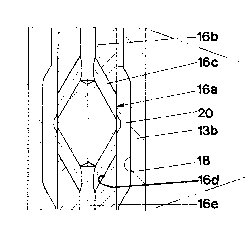Some of the information on this Web page has been provided by external sources. The Government of Canada is not responsible for the accuracy, reliability or currency of the information supplied by external sources. Users wishing to rely upon this information should consult directly with the source of the information. Content provided by external sources is not subject to official languages, privacy and accessibility requirements.
Any discrepancies in the text and image of the Claims and Abstract are due to differing posting times. Text of the Claims and Abstract are posted:
| (12) Patent Application: | (11) CA 2009861 |
|---|---|
| (54) English Title: | DRILL BIT |
| (54) French Title: | OUTIL DE FORAGE |
| Status: | Deemed Abandoned and Beyond the Period of Reinstatement - Pending Response to Notice of Disregarded Communication |
| (51) International Patent Classification (IPC): |
|
|---|---|
| (72) Inventors : |
|
| (73) Owners : |
|
| (71) Applicants : |
|
| (74) Agent: | GOWLING WLG (CANADA) LLP |
| (74) Associate agent: | |
| (45) Issued: | |
| (22) Filed Date: | 1990-02-12 |
| (41) Open to Public Inspection: | 1990-08-13 |
| Availability of licence: | N/A |
| Dedicated to the Public: | N/A |
| (25) Language of filing: | English |
| Patent Cooperation Treaty (PCT): | No |
|---|
| (30) Application Priority Data: | ||||||
|---|---|---|---|---|---|---|
|
ABSTRACT OF THE DISCLOSURE
The present invention relates to a drill bit (11) intended to
be included in a drill string (10) for top hammer drilling,
said drill string (10) including a set of central rod members
(12) for transferring impact energy to the drill bit (11) and
a set of tubular members (13) surrounding the set of rod
members (12) for transferring rotation to the drill bit (11).
The invention also relates to a tubular member (13b) and to a
drill string (10). In drilling equipments of the type
mentioned above it is favourable - especially for greater
diameters, preferably above 125 mm - to guide the flushing
medium in an internal channel in the set of rod members (12).
In order to guarantee lubrication of the splines coupling
(14) through the lubricant that is mixed into the flushing
medium, an intermediate section (16a) of the drill bit (11)
is provided with branch channels (16c, 16d) to discharge the
flushing medium to and from a recess (18) in the space
between the drill bit (11) and the set of tubular members (13).
Note: Claims are shown in the official language in which they were submitted.
Note: Descriptions are shown in the official language in which they were submitted.

2024-08-01:As part of the Next Generation Patents (NGP) transition, the Canadian Patents Database (CPD) now contains a more detailed Event History, which replicates the Event Log of our new back-office solution.
Please note that "Inactive:" events refers to events no longer in use in our new back-office solution.
For a clearer understanding of the status of the application/patent presented on this page, the site Disclaimer , as well as the definitions for Patent , Event History , Maintenance Fee and Payment History should be consulted.
| Description | Date |
|---|---|
| Inactive: IPC from MCD | 2006-03-11 |
| Inactive: IPC from MCD | 2006-03-11 |
| Inactive: IPC from MCD | 2006-03-11 |
| Inactive: Abandon-RFE+Late fee unpaid-Correspondence sent | 1997-02-12 |
| Inactive: Adhoc Request Documented | 1997-02-12 |
| Time Limit for Reversal Expired | 1994-08-13 |
| Application Not Reinstated by Deadline | 1994-08-13 |
| Deemed Abandoned - Failure to Respond to Maintenance Fee Notice | 1994-02-14 |
| Inactive: Adhoc Request Documented | 1994-02-14 |
| Application Published (Open to Public Inspection) | 1990-08-13 |
| Abandonment Date | Reason | Reinstatement Date |
|---|---|---|
| 1994-02-14 |
Note: Records showing the ownership history in alphabetical order.
| Current Owners on Record |
|---|
| SANDVIK AB |
| Past Owners on Record |
|---|
| LARS K. LARSSON |
| SVEN P. LILJEBRAND |